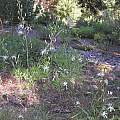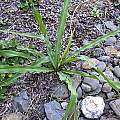This page lists alphabetically genera or species from Ca-Cl recommended for growing in shade by members of the PBS list, sometimes with comments, followed by the name and the location of the person who suggested them, usually from experience growing them. There are links for more information and if we have photos of these plants on the wiki, we have included a few photos to illustrate them on this page.
Caladium was a favorite genus for shade of Boyce Tankersley when he lived in Galveston, Texas, zone 8.
Calathea species and cultivars were favorite shade bulbs of Boyce Tankersley when he lived in the cloud forests of Costa Rica.
Calochortus albus was suggested by Mary Sue Ittner, Northern California and Jane McGary, Oregon.
Calochortus amabilis was suggested by Mary Sue Ittner, Northern California.
Calochortus monophyllus was suggested by Mary Sue Ittner, Northern California.
Calydorea amabilis was recommended by Alberto Castillo.
Canna is a genus mentioned by two people as having species or cultivars suitable for shade. Boyce Tankersley was fond of an an incredibly tall one that was native when he worked at a garden located in the cloud forests of southern Costa Rica.
Canna indica is a species that Lin Grado from northeast Texas (zone 8a) absolutely loves in partial to mostly shade. His soil is acid, sugar sand, improved with compost and alfalfa tea.
Canna 'Cleopatra' was also recommended by Lin Grado.
Canna 'Pretoria' was also recommended by Lin Grado.
Cardiocrinum was mentioned by Mathew Gale, Birmingham, UK who said the highly scented flowers were definitely worth the wait and until then you could enjoy the glossy heart-shaped leaves.
Cardiocrinum giganteum was one of Boyce Tankersley’s favorite woodland bulbs during a time he lived on the west coast of Scotland. Jane McGary from Oregon recommends it too if you have a big space in the shade.
Cardiocrinum giganteum var. yunnanense was described by Ernie O’Byrne, Eugene Oregon as creating suspense in the spring when the huge purple tinted leaves begin to unfurl. It produces a huge bloom stalk surmounted by enormous and fragrant white bells. Since it takes as long as 7 years from seed or three to four from an offset when the parent dies after blooming, it is very exciting when it finally blooms.
Cautleya species were recommended by Mathew Gale, Birmingham, UK for their hardiness and bright orange, red and yellow flowers.
Chionodoxa was mentioned by Jim Shields from central Indiana as a genus that naturalizes very nicely in light shade.
Chlorogalum pomeridianum is found in various habitats in nature, many of them in full sun. Mary Sue Ittner has found it grows almost too well in her shady garden, flowering and increasing under redwoods where it gets very little light.
Claytonia virginica was recommended by Jim Shields, central Indiana.
Clintonia andrewsiana has great leaves, pink flowers and blue berries. Recommended by Mary Sue Ittner, coastal Northern California.
Clivia was suggested for colder areas shielded from the winter cold by growing them in a green house or moving them to a window in winter by Chuck Gleaves in Ohio and Jim Shields in Indiana. Rhoda McMaster from South Africa also recommended the whole genus. In writing about the species Jim Shields reported that besides Clivia miniata, Clivia gardenii and Clivia robusta need shade and Clivia caulescens and Clivia nobilis can tolerate sun, but survive in the shade.
Clivia miniata was a favorite of Pat Colville and Ann, Southern California, and Jennifer Hildebrand, when she lived there.
Index for Bulbs for Shade - Bulbs for Shade A-B - Bulbs for Shade Co-Cy - Bulbs for Shade D-G - Bulbs for Shade H-Lu - Bulbs for Shade Ly-O - Bulbs for Shade P-Z
































